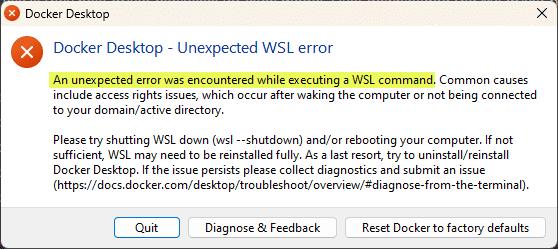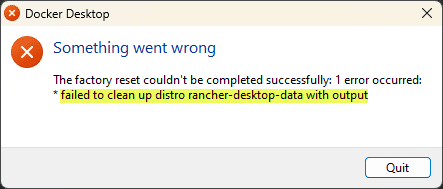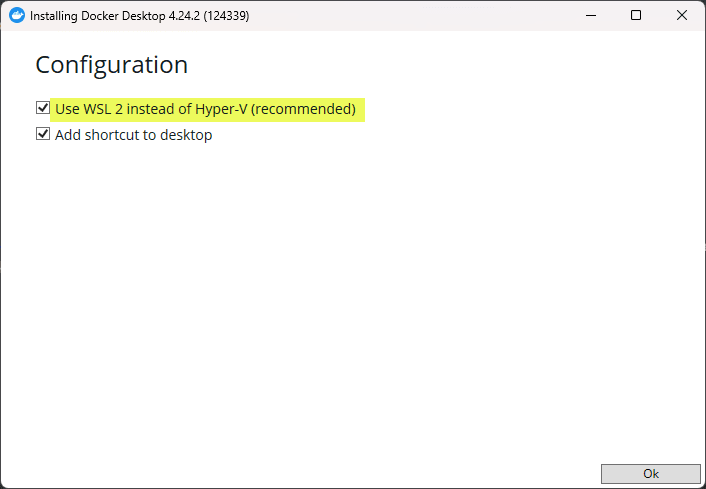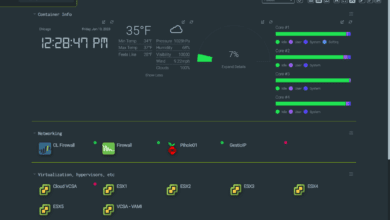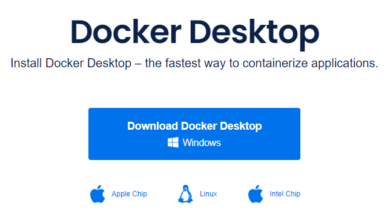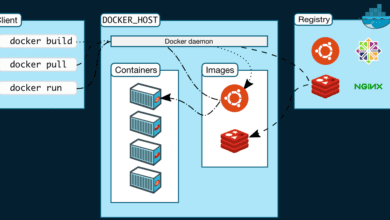Docker Desktop Unexpected WSL Error Fix
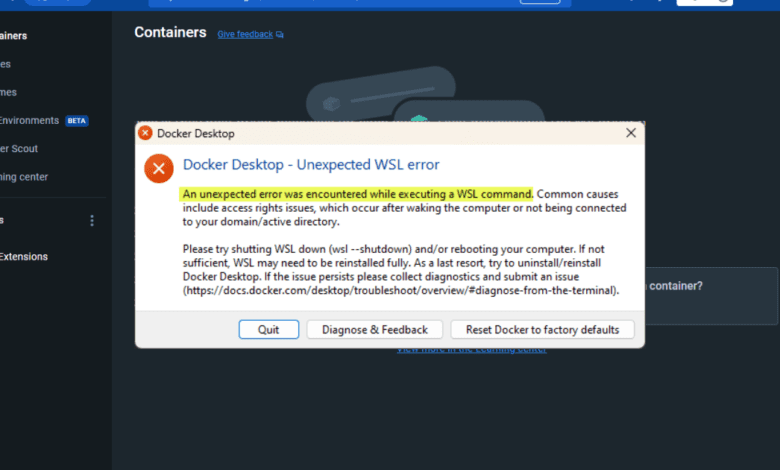
Docker Desktop is a great tool for developers, DevOps pros, and home lab enthusiasts and allows you to interact with the tool without having to install Docker and use it from the command line in Linux. However, the unexpected WSL error often appears post-Docker Desktop installation when executing a WSL command. Several different issues, including access rights, can trigger this error. This post combines a few different solutions to resolve this Docker Desktop error.
Understanding the Unexpected Error
The Docker Desktop unexpected WSL error is often encountered while executing a WSL command. The below error is commonly reported:
“An unexpected error was encountered while executing a WSL command”
Below is a screenshot of the error opening Docker Desktop, noting an unexpected error occurred:
This error hints at issues with the Windows Subsystem for Linux (WSL), which is required when running Docker on Windows if you have selected it during the installation. The error in question shows research effort is needed along the lines of WSL and Docker Desktop. Let’s methodically cover a few solutions.
Solutions to try
Below, let’s key in on a few of the common culprits when you receive the WSL error. If one is not the answer, you can try the other solutions listed. Let’s consider:
Removing conflicting environments
Docker settings adjustment
Config file modification
Stopping and unregistering Docker Desktop
Shutting WSL down, uninstalling Docker Desktop, and reinstalling Docker Desktop
Note, if you are experiencing Docker Desktop starting forever, for an answer copy link here: Docker Desktop Starting Forever Windows 11 or 10 Error.
1. Remove conflicting environments
One thing to look for is if you have any conflicting environments setup on your Docker Desktop host. In my case, I had Rancher Desktop installed. If you run other solutions like Rancher Desktop, these can conflict with Docker Desktop.
In my case, I had to uninstall Rancher Desktop. You can be clued in on this as the culprit if you select Reset Docker to factory defaults. When I did this, I received the following error:
Error removing Rancher Desktop components.
Navigate to Programs and Features and uninstall Rancher Desktop.
2. Docker Settings Adjustment
A common solution involves adjusting Docker settings. Navigate to the following directory in your user account:
AppData/Roaming/DockerOpen the settings file (a JSON file), and ensure the settings are configured as shown:
"integratedWslDistros": [] and "enableIntegrationWithDefaultWslDistro": falseSave the changes and restart Docker Desktop to apply the new settings.
3. Config File Modification
Modifying the config file is another viable solution. Delete the config file located at the following path:
AppData/Roaming/Docker/settings.jsonThen restart Docker Desktop. Docker Desktop will create a new default settings.json file. You may want to save the old settings.json file for comparison with the new one after you restart Docker Desktop.
4. Stopping and unregistering Docker Desktop
Stopping Docker Desktop can be done by executing the following commands:
wsl --unregister docker-desktop Next, restart Docker Desktop.
5. Shutting WSL down, uninstalling Docker Desktop, and reinstalling Docker Desktop
You can also use the command line to shutdown WSL. Relevant commands include:
##WSL Commands
wsl --list --running
wsl --list --all
wsl --terminate <DistributionName>
##Remove WSL
1. win + r > optionalfeatures
2. Remove "Windows Subsystem for Linux"
3. Reboot
##Remove Docker Desktop
1. win + r > appwiz.cpl
2. Docker Desktop > UninstallIf you uninstall WSL, installing WSL is a reverse of the same process as is the installation process of Docker Desktop.
Version-Specific Resolutions
Specific Docker Desktop versions might cause this error. Uninstalling the problematic version and installing a different one, alongside a WSL shutdown and Docker service restart, might resolve the issue.
Troubleshooting Matrix
| Solution Category | Description | Specific Action | Path/Command | Additional Notes |
| Docker Settings | Adjust settings within Docker’s configuration file to rectify common WSL error triggers. | Modify specific settings | Navigate to AppData/Roaming/Docker, adjust settings in JSON file, save changes, and restart Docker Desktop | A simple settings tweak to address the error. |
| Config File Modification | Sometimes, config file issues can cause the unexpected WSL error. Deleting the file allows Docker to create a fresh one with default settings. | Delete settings.json file | AppData/Roaming/Docker/settings.json | Backup old config file before deletion. |
| Command Line | Utilize command line to unregister Docker Desktop from WSL, potentially resolving the error. | Execute specific command | wsl –unregister docker-desktop in terminal | Ensure Docker Desktop is stopped before executing. |
| Version-Specific | Certain Docker Desktop versions might harbor bugs causing the error. Switching versions could rectify the issue. | Uninstall problematic version, install different version | – | Ensure to shutdown WSL and restart Docker service. |
| Windows Features | Essential Windows features must be enabled for Docker to function correctly. | Ensure necessary features are enabled | – | Check Windows features through Control Panel. |
| Nested Virtualization | Nested virtualization support is crucial for running Docker containers efficiently. | Verify nested virtualization is enabled | Execute systeminfo command in Command Prompt | Particularly important for systems running Intel processors. |
| Azure VMs | Azure Virtual Machines (VMs) can be used with Docker Desktop provided nested virtualization is enabled. | Ensure nested virtualization is enabled | – | Azure VMs offer a cloud-based environment for Docker operations. |
| Netsh Winsock | Network issues via netsh winsock can interfere with Docker Desktop. Resetting it might solve the problem. | Reset netsh winsock | Execute netsh winsock reset in Command Prompt | Restart computer post-command execution. |
| Disk Space | Adequate disk space is required for Docker Desktop installation and operation. | Ensure sufficient disk space is available | – | Insufficient disk space can lead to various errors. |
| Hyper-V | Hyper-V supports the creation and management of virtual machines, aiding in resolving Docker Desktop and WSL related issues. | Ensure Hyper-V is enabled | – | Hyper-V is a vital component for virtualization on Windows. |
Docker Desktop installation
The Docker installation process is straightforward for Docker Desktop if you need to reinstall. As you can see when installing Docker Desktop, it uses Windows Subsystem for Linux.
Download Docker Desktop here: Docker Desktop.
Navigate through the installation prompts. After installing, you can open Docker. Below, we see that WSL is recommended over Hyper-V.
Other troubleshooting
Windows features such as the Windows Hypervisor Platform and Virtual Machine Platform are crucial for Docker’s smooth operation. Ensuring these features are enabled could be a step towards resolving the unexpected error. Moreover, nested virtualization, especially on machines running Intel processors, could be another aspect to explore for fixing this error.
Frequently Asked Questions
Note the following related question feed:
The error typically arises due to access rights issues, which might occur when the computer wakes up or is not connected to your domain/active directory. It’s often encountered while executing a WSL command on Docker Desktop.
Yes, the Windows Hypervisor Platform is essential as it supports the running of Docker Desktop. Similarly, having the Virtual Machine Platform enabled is crucial for the seamless operation of Docker Desktop on Windows.
To check if nested virtualization is enabled, you can use the command prompt on Windows. Execute the command systeminfo and look for “Hyper-V Requirements.” If nested virtualization is enabled, you’ll see a “Yes” next to “Virtualization Enabled In Firmware.”
If the error persists, it’s advisable to review the Docker Desktop installation process, ensure the Windows Subsystem for Linux is installed correctly, and that all necessary Windows features are enabled. Additionally, reinstalling Docker Desktop or reverting to a previous version might resolve the issue.
Yes, executing netsh winsock reset in the command prompt and restarting your computer can help resolve netsh winsock issues that might interfere with Docker Desktop.
Insufficient disk space can cause problems when installing or running Docker Desktop. Ensure you have enough disk space available to facilitate the Docker Desktop data and operations.
Yes, enabling Hyper-V is often helpful in resolving issues related to Docker Desktop and WSL as it supports the creation and management of virtual machines on Windows.


